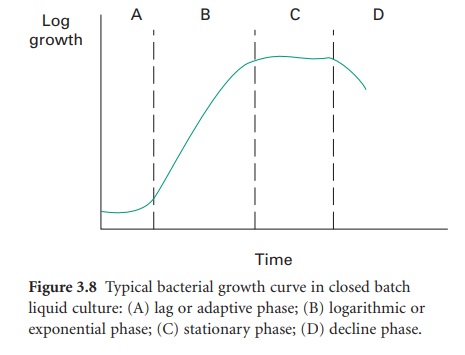Bacterial Growth on Different Media
| Home | | Pharmaceutical Microbiology | | Pharmaceutical Microbiology |Chapter: Pharmaceutical Microbiology : Bacteria
If microorganisms are immobilized on a solid surface from which they can derive nutrients and remain moist, cell division will cause the daughter cells to form a localized colony.
BACTERIAL GROWTH ON
DIFFERENT MEDIA
Growth on solid surfaces
If microorganisms are
immobilized on a solid surface from which they can derive nutrients and remain
moist, cell division will cause the daughter cells to form a localized colony.
In spite of the small size of the individual organisms, colonies are easily visible
to the naked eye. Indeed, microbial growth can often be seen on the tonsils of
an infected individual or as colonies on discarded or badly stored foods. In
the laboratory solidified growth media are deployed to separate different types
of bacteria and also as an aid to enumerating viable cell numbers. These media
comprise a nutrient soup (broth) that has been solidified by the addition of
agar (see Chapter 2). Agar melts and dissolves in boiling water but will not re-solidify
until the temperature is below 45 °C. Agar media are used in the laboratory
either poured as a thin layer into a covered dish (Petri dish or plate) or
contained within a small, capped bottle (slant). If suspensions of different
species of bacteria are spread on to the surface of a nutrient agar plate then
each individual cell will produce a single visible colony. These may be counted
to obtain an estimate of the original number of cells. Different species will
produce colonies of slightly different appearance, enabling judgements to be
made as to the population diversity. The colour, size, shape and texture of
colonies of different species of bacteria vary considerably and form a useful
diagnostic aid to identification. Transfer of single colonies from the plate to
a slant enables pure cultures of each organism to be maintained, cultured and
identified.
Growth in liquids
When growing on a solid
surface the size of the resultant colony is governed by the local availability
of nutrients. These must diffuse through the colony. Eventually growth ceases
when the rate of consumption of nutrients exceeds the rate of supply. When
grown in liquids the bacteria, being of colloidal dimensions and sometimes
highly motile, are dispersed evenly through the fluid. Nutrients are therefore
equally available to all cells. When considering growth of bacterial
populations in liquids it is necessary to consider whether the environment is
closed or open with respect to the acquisition of fresh nutrient. Closed
systems are typified by batch culture in closed glass flasks. In these waste
products of metabolism are retained and all the available nutrients are present
at the beginning of growth. Open systems, on the other hand, have a continual
supply of fresh nutrients and removal of waste products.
A) Liquid batch culture (closed)
Figure 3.8 shows the
pattern of population growth obtained when a small sample of bacteria is placed
within a suitable liquid growth medium held in a glass vessel. As the increase
in cell numbers is exponential (1, 2, 4, 8, 16, etc.) then during active growth
a logarithmic plot of cell number against time gives a straight line (B). This
period is often referred to as the logarithmic
growth phase, during which the generation or doubling time may be calculated
from the slope of the line. However, the exponential phase is preceded by a lag period (A), during which time the
inoculum adapts its physiology to that required for growth on the available nutrients.
As growth proceeds nutrients are consumed and waste materials accumulate. This has
the effect of reducing the rate of growth (late
logarithmic phase) towards an eventual halt (stationary phase, C). Starvation during the stationary phase will
eventually lead to the death of some of the cells and adaptation to a dormant
state in others (decline phase, D).
Patterns of growth such as this occur within inadequately preserved
pharmaceutical products, in water storage tanks and in industrial fermentations.
B) Growth
in open culture
Except under
circumstances of feast–famine, growth of bacteria in association with humans
and in our environment is subject to a gradual but continuous provision of
nutrients and a dilution of waste products. Under such circumstances the rate
of growth of bacteria is governed by the rate of supply of nutrients and the
population size. Accordingly, bacteria in our gastrointestinal tracts receive a
more or less continuous supply of food and excess bacteria are voided with the
faeces (indeed, bacteria make up >90% of the dry mass of faeces). In many situations the bacteria
become immobilized, as a biofilm, upon a surface and extract nutrients from the
bulk fluid phase.

Related Topics
